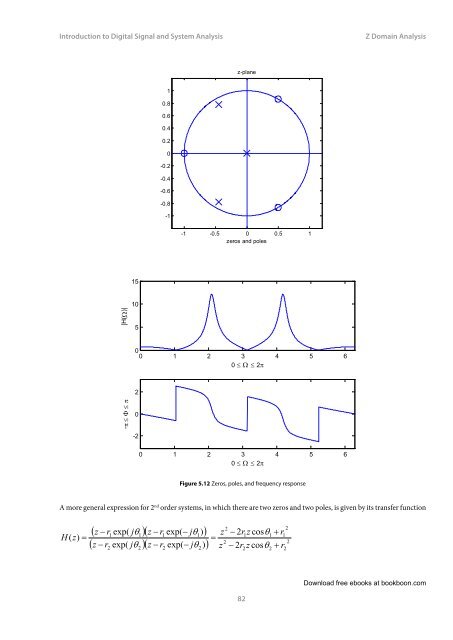Introduction to Digital Signal and System Analysis - Tutorsindia
Introduction to Digital Signal and System Analysis - Tutorsindia
Introduction to Digital Signal and System Analysis - Tutorsindia
You also want an ePaper? Increase the reach of your titles
YUMPU automatically turns print PDFs into web optimized ePapers that Google loves.
<strong>Introduction</strong> <strong>to</strong> <strong>Digital</strong> <strong>Signal</strong> <strong>and</strong> <strong>System</strong> <strong>Analysis</strong><br />
Z Domain <strong>Analysis</strong><br />
z-plane<br />
1<br />
0.8<br />
0.6<br />
0.4<br />
0.2<br />
0<br />
-0.2<br />
-0.4<br />
-0.6<br />
-0.8<br />
-1<br />
-1 -0.5 0 0.5 1<br />
zeros <strong>and</strong> poles<br />
15<br />
|H(W)|<br />
10<br />
5<br />
0<br />
0 1 2 3 4 5 6<br />
0 ≤ W ≤ 2p<br />
2<br />
-p ≤ Φ ≤ p<br />
0<br />
-2<br />
0 1 2 3 4 5 6<br />
0 ≤ W ≤ 2p<br />
Figure 5.12 Zeros, poles, <strong>and</strong> frequency response<br />
A more general expression for 2 nd order systems, in which there are two zeros <strong>and</strong> two poles, is given by its transfer function<br />
H ( z)<br />
=<br />
2<br />
2<br />
( z − r1<br />
exp( jq1)(<br />
z − r1<br />
exp( − jq1)<br />
) z − 2r1<br />
z cosq1<br />
+ r1<br />
=<br />
2<br />
2<br />
( z − r exp( jq<br />
)( z − r exp( − jq<br />
)) 2<br />
2<br />
2<br />
2<br />
z<br />
− 2r<br />
z cosq<br />
+ r<br />
2<br />
2<br />
2<br />
82<br />
Download free ebooks at bookboon.com
















